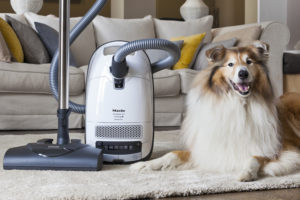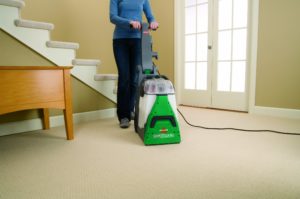
Ideally, when you buy a home with carpets or have them installed, they’ll last for years with gradual wear and tear over decades. However, sometimes things go sideways, and your carpet might start looking like the surface of a pond on a windy day. If your carpet appears to be developing waves or wrinkles, you’re going to want to read this article. Essentially, you’re dealing with carpet buckling. It’s also known as stretching or rippling, and it essentially means your carpet is loose or out of place in some way. We’re going to dive into why it occurs and how to fix it.
Carpets ripple due to high humidity levels in the home
Humidity is one of the biggest enemies of carpets, whether for mold growth, or in this case, carpet buckling. Humidity is particularly likely to strike in parts of the US and Canada that experience four-season climates, because there is a vast difference between indoor humidity levels in the summer compared to fall and winter. And if you’re somewhere where it’s humid year round, it’s even worse. In either situation, high humidity leads to the carpet absorbing excess air moisture and swelling as a result.
If you’re dealing with a mild case of humidity-induced rippling, the carpet might return to a normal level of flatness when ambient moisture levels return to their typical levels. However, with severe buckling, you might need to have the buckles removed by re-stretching, which we’ll discuss below.
To keep your carpets from rippling when it gets humid, or at least to reduce the odds of this occurring, you’ll want to turn on air conditioning (when it’s also hot) or dedicated dehumidifiers to pull moisture from the air so your carpet doesn’t act as a giant natural dehumidifier.
Your carpets will buckle if you (incorrectly) drag heavy things over them
Aside from moisture, the second most common reason for carpet warp is the incorrect passage of heavy materials over the carpet surface. If you drag things like furniture or appliances over your carpet without using plywood to “walk” them across, the objects will create waves the same way you would by pushing your hand through a sandbox, and the carpet will distort as a result.
To keep your carpets from warping when you move heavy objects across them, you’ll either want to lift and carry them or use wooden planks (e.g., plywood) as skis to push them wherever you need them to go.
Perhaps it was never installed properly to begin with
Alternatively, if your wall-to-wall carpet was not correctly installed from the start–which means tightly stretching it and then holding it in place along its edges–it’s likely to slightly loosen over time, which can lead to rippling. Carpet installers should ideally use power stretchers to stretch carpets on installation to lower odds of wrinkling and stretching later.
Similarly, if you plan to install your carpet somewhere with significantly different ambient conditions, such as high variations in temperature, humidity, or both, you’ll want to give the carpet time to acclimate, or equalize, before it’s installed; a carpet that hasn’t been acclimated is more likely to buckle upon installation.
If the installation was right, the underpad may be wrong
Maybe the installation was done correctly and the carpet was stretched the way it was supposed to be. But if you or your installers didn’t use a sufficiently dense carpet cushion, or underpad, the carpet might still end up buckling due to too much flexibility. To keep this issue from arising, you need to use the right underpad for the carpet.
A wet carpet due to flooding or poor cleaning will also stretch
Finally, a carpet might buckle simply due to an overload of water from flooding or a botched cleaning job. This is an acute version of the high humidity problem, which itself is a chronic version of this issue. The bottom line is that if your carpet gets very wet because your home flooded (e.g., due to a failed sump pump and the lack of a backup pump) or because you used too much water when steam cleaning, your carpet will be particularly vulnerable to stretching. The solution? Make sure you have anti-flooding procedures in place and learn to properly clean your carpeting.
To solve a stretched carpet, you’ll need to re-stretch it, and soon
Now that we’ve established the myriad reasons why your carpet might have begun to buckle, let’s get down to what’s ultimately most important: how do you fix it? Well, a buckled carpet must be re-stretched, and the sooner you do so, the better. This is because extended rippling will only become worse with time, and your carpet will eventually start to crease.
Once you’re dealing with a creased carpet, or one where there’s so much rippling that your carpet starts developing sharp folds, like a creased shirt or sheet of paper, you’re no longer going to be able to completely fix it. Even though you might smoothen the ripples, the crease will remain and the buckles will still be visible, even if only slightly.
While you might be able to re-stretch your carpet on your own in a case of mild buckling in a limited area away from seams and posts, it’s generally best to have the process done by professional carpet installers. If you’re dealing with a carpet you bought from a retailer, you might have warranty coverage to cover the expenses. If not, you’ll need to budget at least $100, which may rise with ripple severity and additional work necessary to complete the re-stretching, including opening and closing seams or moving furniture.
Reduce your odds of stretching by cleaning your carpets frequently

While you can’t prevent carpet rippling simply by vacuuming and carpet cleaning, if you get into the habit of frequently maintaining your carpets, you’ll be far more likely to notice if something’s amiss. On top of this, a regular cleaning schedule will also help you keep other enemies of carpet longevity at bay, such as mold, mildew, and staining and soiling.

For deep cleaning, we recommend the Bissell 86T3 Big Green. It’ll clean as well as any industrial extractor under $1,000 and is a steal for the price. For vacuuming, you can handle all styles and piles of carpeting with a buy-it-for-life canister like the the Miele Complete C3 Cat & Dog or the Miele Compact C2 Electro+. Both are designed to last long enough to be handed down to your children, and will work equally well on carpets and hardwood floors.
![]() You can buy the Bissell 85T3 Big Green carpet cleaner here on Amazon. You can buy the Miele Complete C3 Cat & Dog here or buy the Miele Compact C2 Electro+ here.
You can buy the Bissell 85T3 Big Green carpet cleaner here on Amazon. You can buy the Miele Complete C3 Cat & Dog here or buy the Miele Compact C2 Electro+ here.
![]() Canadians can buy the Miele C3 Cat & Dog here, the Compact Electro+ here, and the Bissell Big Green here.
Canadians can buy the Miele C3 Cat & Dog here, the Compact Electro+ here, and the Bissell Big Green here.
 If you find our research on PMC helpful, you can follow our efforts to keep maniacally reviewing home cleaning tools by shopping through our links above. We promise to keep fighting the good fight against every horror children, animals, and grown, yet messy humans can inflict upon a clean home.
If you find our research on PMC helpful, you can follow our efforts to keep maniacally reviewing home cleaning tools by shopping through our links above. We promise to keep fighting the good fight against every horror children, animals, and grown, yet messy humans can inflict upon a clean home.

